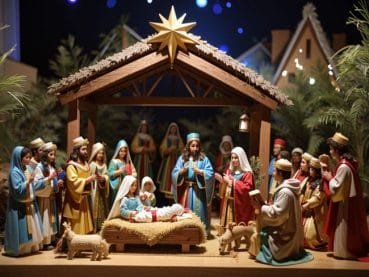The Significance of Religious Christmas Traditions in Modern Celebrations
Christmas is a time of joy and celebration, and for many people, it holds deep religious significance. Religious Christmas traditions have been an integral part of the holiday season for centuries, and they continue to play a significant role in modern celebrations.

From attending religious services to decorating the home with religious symbols and participating in charitable acts, religious Christmas traditions provide a way to connect with family, friends, and faith during the holiday season. In this article, we will explore the origins and significance of these traditions, and provide tips for incorporating them into your own holiday celebrations.
Key Takeaways:
- Religious Christmas traditions are an important aspect of the holiday season for many people.
- These traditions have been practiced for centuries, and continue to play a significant role in modern celebrations.
- Attending religious services, participating in acts of charity, and incorporating religious symbols into the home are all examples of religious Christmas traditions.
- By embracing these traditions, you can connect with your faith and deepen your appreciation for the holiday season.
- There are many ways to incorporate religious Christmas traditions into your celebrations, and we will provide tips and suggestions throughout this article.
The Origins of Religious Christmas Traditions
Religious Christmas traditions have a rich history that dates back centuries. The celebration of Christmas originally began as a Christian holiday to honor the birth of Jesus Christ. The holiday was first observed on December 25th in Rome in the year 336 A.D.
The customs and traditions associated with Christmas have evolved over time and have been influenced by various cultures. One of the most well-known Christmas traditions, the Christmas tree, has its roots in Germany. The tradition began in the 16th century when people brought evergreen trees into their homes and decorated them with candles and ornaments.
The tradition of exchanging gifts during Christmas has its roots in the story of the Three Wise Men who brought gifts to the baby Jesus. This practice was later adopted by Christians as a way to spread the message of love and generosity.
Another popular Christmas tradition that has both religious and cultural significance is the nativity scene. The nativity scene depicts the birth of Jesus Christ and is a symbolic representation of the story told in the Bible.
Overall, the origins of religious Christmas traditions are deeply rooted in the Christian faith, but have been influenced and adapted by various cultures over time.
Christian Christmas Traditions Around the World
Christmas is celebrated around the world, and Christian communities have developed unique customs to commemorate the birth of Jesus Christ. From Europe to Africa to Asia, different cultures have infused their own traditions into this significant religious holiday. Here are some examples of Christian Christmas traditions from around the world:
| Country | Tradition |
|---|---|
| Mexico | Posadas, a nine-day festival leading up to Christmas Eve that commemorates Mary and Joseph’s search for a place to stay in Bethlehem. |
| Germany | Decorating evergreen trees with lights and ornaments, a tradition that dates back to the 16th century. |
| Italy | Displaying elaborate Nativity scenes, sometimes including life-sized figures and live animals. |
| Greece | Lighting candles at midnight on Christmas Eve to symbolize the birth of Christ, followed by a feast with family and friends. |
| Ethiopia | Celebrating Christmas on January 7th, following the Julian calendar, with a solemn church service followed by a feast. |
These are just a few examples of the diverse Christian Christmas traditions around the world. Each one highlights the unique cultural and religious heritage of its respective community, while also embracing the spirit of the holiday season.
Traditional Religious Customs in Christmas Celebrations
One of the most significant aspects of celebrating Christmas religiously is observing traditional customs that have been passed down through generations. These customs not only symbolize the birth of Jesus Christ but also provide an opportunity for families to come together in celebration.
Attending religious services is an essential part of Christmas for many families. Churches conduct special services, such as Midnight Mass, to mark the occasion. The Mass commemorates the birth of Jesus Christ, and the singing of traditional hymns and carols adds to the festive atmosphere.

Another tradition that is commonly observed during Christmas is setting up nativity scenes. These scenes depict the birth of Jesus Christ and are often placed in homes, churches, and public spaces. They are meant to remind people of the true meaning of Christmas and to bring the story of the first Christmas to life.
The lighting of Advent candles is another traditional practice that holds great significance. The candles represent the four weeks leading up to Christmas and symbolize hope, peace, joy, and love. Lighting the candles each week is a way of preparing for the celebration of Jesus Christ’s birth.
These traditional customs play an integral role in religious Christmas celebrations. They offer a sense of continuity and connection with the past and emphasize the importance of faith and family.
The Symbolism and Significance of Religious Christmas Decorations
Religious Christmas decorations hold a significant place in the holiday traditions of many cultures around the world. These decorations serve as symbols of faith and reminders of the true meaning of Christmas. Let’s take a closer look at some of the most common religious Christmas decorations and their significance.
The Christmas Tree
The Christmas tree is a beloved symbol of the holiday season, and for Christians, it holds great significance. The evergreen tree represents eternal life, while the star on top symbolizes the Star of Bethlehem that led the Wise Men to the birthplace of Jesus Christ. The tree itself serves as a reminder of the cross on which Jesus was crucified, while the lights that adorn it represent the light of the world that Jesus brought with his birth.
The Wreath
The Christmas wreath is another popular decoration that holds religious significance. Its circular shape represents eternity and the unending love of God. The colors of the wreath – typically green and red – represent eternal life and the blood of Jesus, respectively. The addition of a candle in the center of the wreath symbolizes the coming of Christ as the light of the world.
The Nativity Scene
The Nativity scene, also known as a crèche, is a depiction of the birth of Jesus Christ. It typically features figures of the Holy Family, the Wise Men, shepherds, and various animals. This decoration serves as a reminder of the humble beginnings of Jesus’ life and the miraculous circumstances of his birth. It also emphasizes the importance of family and community during the holiday season.
The Advent Calendar
The Advent calendar is a traditional Christian decoration that counts down the days until Christmas. It typically features small doors that open to reveal a picture or piece of chocolate for each day leading up to Christmas. This decoration serves as a reminder of the anticipation and excitement of the holiday season, as well as the importance of preparing one’s heart for the coming of Christ.
The Candle
Candles are a common decoration during the Christmas season, particularly during Advent. The lighting of the candles represents the coming of Christ as the light of the world. Additionally, the four candles of the Advent wreath represent the four weeks leading up to Christmas and the themes of hope, peace, joy, and love.
As you decorate for the holiday season, consider incorporating some of these religious Christmas decorations into your home. Not only will they add meaning and significance to your celebrations, but they will serve as reminders of the true reason for the season – the birth of Jesus Christ.
Retaining Religious Focus in Modern Christmas Celebrations
Amidst the hustle and bustle of the holiday season, it can be easy to lose sight of the religious significance of Christmas. However, celebrating Christmas religiously can be a fulfilling and meaningful experience. Here are some tips and suggestions for retaining a religious focus in modern Christmas celebrations:
Make Time for Religious Rituals
Attending religious services such as a midnight Mass or a Christmas Day church service can help ground your celebrations in faith. Lighting Advent candles, praying together as a family, and reflecting on the story of the Nativity are other ways to incorporate religious rituals into your holiday festivities.
Create Meaningful Traditions
Consider starting a new family tradition that focuses on the religious aspect of Christmas. For example, you could read the Nativity story together as a family, or create an Advent calendar that includes daily Scripture readings or acts of charity.
Emphasize Religious Christmas Decorations
Incorporating religious Christmas decorations into your home can help create a sacred space for the holiday. You can set up a Nativity scene, hang a wreath with a religious symbol, or decorate your Christmas tree with ornaments that have a religious significance.
Participate in Religious Christmas Rituals
Many churches offer opportunities to participate in religious Christmas rituals such as a Living Nativity or a service of lessons and carols. Attending these events can help you connect with your faith and community during the holiday season.
By incorporating these tips and suggestions into your Christmas celebrations, you can retain a religious focus and deepen your connection to faith during the holiday season.
Incorporating Religious Christmas Traditions into Family Celebrations
As the holiday season approaches, it’s essential to remember the importance of religious Christmas traditions in the celebration of this special time. Incorporating religious customs into your family’s festivities is an excellent way to impart the true meaning of the holiday season to your loved ones. Here are some tips to help you embrace and incorporate religious Christmas traditions into your family celebrations.
Read the Nativity Story
Set aside time during your holiday celebrations to read the Nativity story. This will allow your family to reflect on the religious significance of Christmas and the birth of Jesus Christ. You can read the story directly from the Bible or use a children’s book that tells the story in a way that’s easy for kids to understand. Many families choose to read the story on Christmas Eve, but you can do it any day that works best for your family.
Participate in Advent Calendars
Advent calendars provide a fun and interactive way for kids to count down to Christmas while remembering the religious significance of the holiday. You can purchase a traditional Advent calendar that features Bible verses or religious imagery, or you can create your own. Fill each day’s compartment with a small religious trinket, such as a miniature angel or a small ornament with a religious symbol.
Engage in Acts of Charity
Christmas is a time for giving, and what better way to honor the religious significance of the holiday than by engaging in acts of charity? Consider donating your time or resources to a local church or charity organization. You can also involve your kids in the process by encouraging them to donate some of their own money or toys to those in need. This will help them understand the importance of giving to others and the true meaning of the holiday season.
By incorporating religious Christmas traditions into your family celebrations, you can create a meaningful and memorable holiday experience for your loved ones.
The Intersection of Religious and Cultural Christmas Traditions
Christmas is a time of year when many people observe both religious and cultural traditions. For some, this involves incorporating elements of their cultural heritage into their religious celebrations, while for others, it may mean blending religious practices with modern, secular customs. Whatever your approach, finding ways to embrace both religious and cultural traditions can help make your holiday celebrations more meaningful and enjoyable.
One way to blend religious and cultural traditions is by incorporating traditional foods into your Christmas celebrations. Many cultures have specific dishes or treats that are associated with the holiday season, and by sharing these foods with family and friends, you can bring a sense of togetherness and cultural appreciation to your celebrations.

Another way to blend religious and cultural traditions is by incorporating music and dance into your Christmas celebrations. Many cultures have unique musical traditions associated with Christmas, and by incorporating these traditions into your celebrations, you can create a sense of joy and celebration that transcends cultural boundaries.
Of course, one of the most important ways to blend religious and cultural traditions is by incorporating both into your holiday decorations. Whether you use traditional religious symbols like the nativity scene and Advent wreaths, or incorporate cultural elements like colorful lights and festive decorations, finding ways to celebrate both aspects of the season can help create a sense of unity and belonging.
Ultimately, the intersection of religious and cultural traditions at Christmas is a reflection of the diverse and rich tapestry of our world. By embracing both religious and cultural traditions, we can honor our shared heritage and celebrate the unique beauty of our differences. So, whether you’re lighting the Hanukkah candles, preparing a Kwanzaa feast, or attending midnight Mass, take the time to reflect on the meaning and significance of your traditions, and enjoy the warmth and joy of the holiday season.
FAQ
Q: What are religious Christmas traditions?
A: Religious Christmas traditions are customs and practices that have religious significance and are associated with the celebration of Christmas. These traditions often focus on the birth of Jesus Christ and the religious meaning of the holiday.
Q: Why are religious Christmas traditions important in modern celebrations?
A: Religious Christmas traditions are important in modern celebrations because they help to preserve and pass down the religious significance of the holiday. They provide an opportunity to reflect on the deeper meaning of Christmas and keep the focus on religious observances.
Q: What are the origins of religious Christmas traditions?
A: The origins of religious Christmas traditions can be traced back to ancient customs and religious practices. Many traditions have evolved over time and been influenced by different cultures and beliefs, resulting in the diverse array of religious customs we see today.
Q: What are some Christian Christmas traditions observed around the world?
A: Christian Christmas traditions observed around the world vary depending on the culture and region. Some common traditions include attending midnight Mass, reenacting nativity scenes, singing carols, and exchanging gifts on Christmas Day.
Q: What are traditional religious customs in Christmas celebrations?
A: Traditional religious customs in Christmas celebrations often include attending religious services such as Mass or church services, setting up nativity scenes to depict the birth of Jesus, lighting Advent candles, and participating in prayers and reflections.
Q: What is the symbolism and significance of religious Christmas decorations?
A: Religious Christmas decorations hold symbolic meaning and play a significant role in religious observances. The Christmas tree represents everlasting life, wreaths symbolize eternity and the circle of life, and ornaments can represent various religious themes and symbols.
Q: How can we retain a religious focus in modern Christmas celebrations?
A: To retain a religious focus in modern Christmas celebrations, you can incorporate religious rituals, such as reading the nativity story or participating in Advent calendars. Engaging in prayers, attending religious services, and reflecting on the religious meaning of Christmas can also help maintain a religious focus.
Q: How can we incorporate religious Christmas traditions into family celebrations?
A: Families can incorporate religious Christmas traditions into their celebrations by reading the nativity story together, participating in Advent activities, such as lighting the Advent candles, and engaging in acts of charity or service that align with religious values.
Q: How do religious and cultural Christmas traditions intersect?
A: Religious and cultural Christmas traditions often intersect as various cultures incorporate their religious beliefs into their unique holiday customs and practices. The specific traditions observed may vary depending on the cultural background and religious beliefs of a community or family.
Q: Why should we embrace religious Christmas traditions?
A: Embracing religious Christmas traditions allows us to connect with the deeper meaning of the holiday and keep the religious significance at the forefront. These traditions provide an opportunity for reflection, gratitude, and spiritual growth during the Christmas season.




